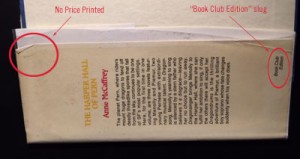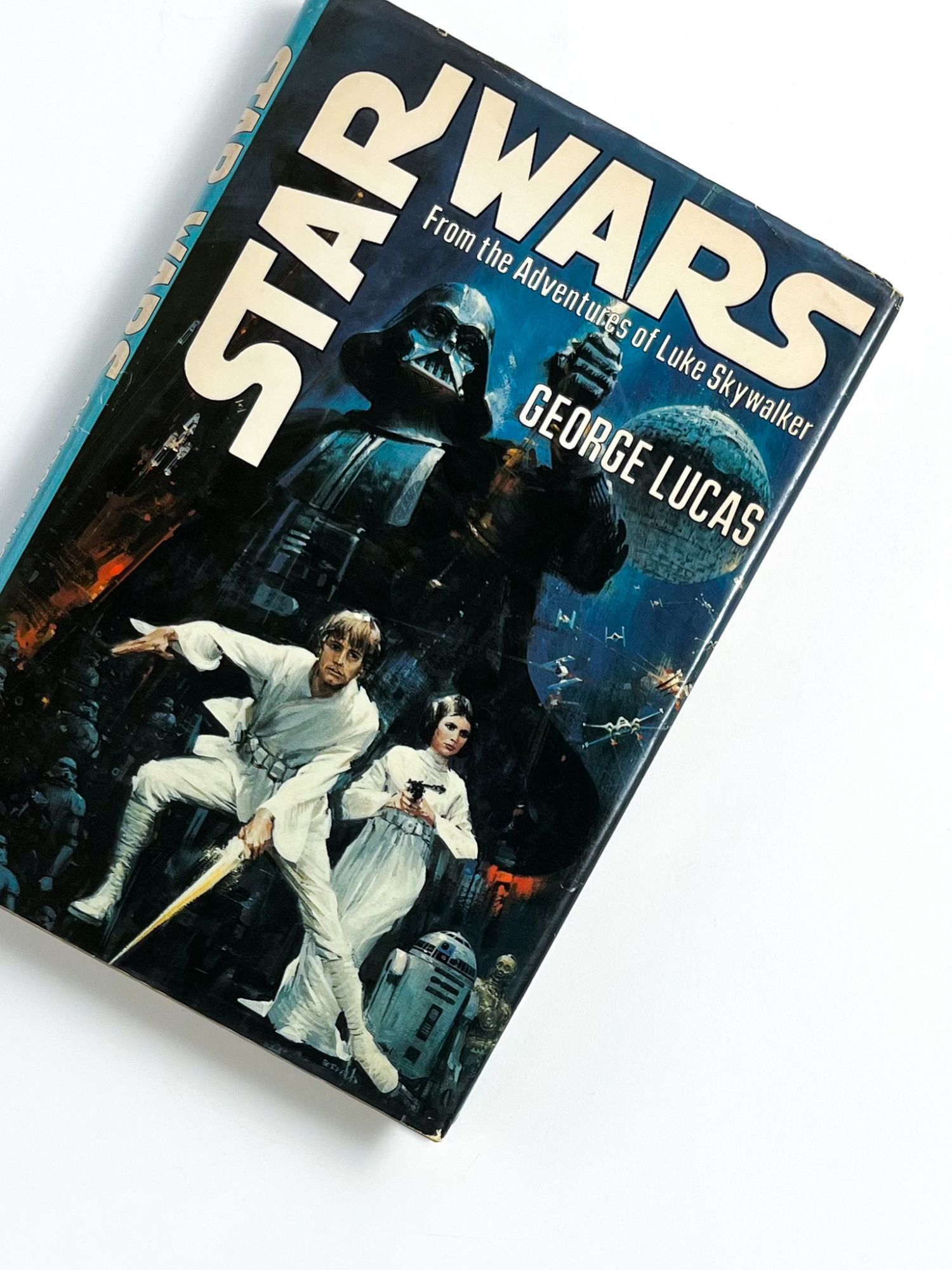Related Information
As the above definition makes clear, "book club editions" are reprints of books for a defined audience. Often printed on lesser-quality paper or in a noticeably smaller trim size (see image above...) to save money, classic book club editions were often sold to a “captive” audience as part of a subscription plan. In terms of monetary value, book club editions are usually at the bottom of the pack, practically valueless. (They don't even rate a definition in the most-recent edition of John Carter and Nicolas Barker's ABC for Book Collectors, an essential reference for book-trade terminology!) However, that does not mean that they are never of interest to any collectors!
“Book Club Editions” usually refers to a mass-market book club like the Book of the Month Club, the Science Fiction Book Club, or others that operate(d) on the subscription model. These clubs should not be confused with fine-press publishers like The Folio Society or the Limited Editions Club, who also produce special editions of previously published books, but utilize top quality materials and artisan craftsmanship.
Oprah’s Book Club
It should be noted that the most common book club of recent years has been Oprah’s Book Club (1996-2011 and reprised as an online book club in 2012). In this case, special editions of the selected title were rarely printed, instead the dust jackets of the books (if in hardcover) were reprinted bearing the Oprah’s Book Club logo -- this was what the novelist Jonathan Franzen famously objected to, believing that the “Oprah” sticker would be Kryphonite to male readers, leading to his novel’s ignominious deselection. New printings were ordered once the selection announcement was made with great fanfare, and these copies were jacketed in the new dust cover (and sometimes existing unsold copies were rejacketed) -- sometimes making first edition, first printings in the original jacket relatively scarce.
Does this make first editions of Oprah’s Book Club selections any more valuable? Not really. Few of the selections met with great critical acclaim, but a great many copies were printed and sold. However, as with movie-tie-in editions, there are always collectors who want the original book, without stickers or other later additions denoting prizes won, movies made, or book club adoptions.
Book of the Month Club
The most-famous book club is the Book of the Month club, which began in 1926, and still exists, although with a much smaller membership than in its heyday, when to be selected by the Book of the Month club was a guarantor of commercial success.
How to spot a book club edition
Although the physical “tells” denoting a book club edition from the trade edition have changed over the years (and differed from club to club), there is often a discrete mention of “Book Club Edition” somewhere on the jacket, and there may be no ISBN or year of publication on the copyright page. Science Fiction Book Club editions are often smaller than the trade hardcovers. (Which some collectors appreciate, as all the books are produced at a uniform trim size, making for a tidy display when shelved together.) As these books were never available for sale in conventional bookstores, there may be no price or barcode on the dust jacket, the back cover of the jacket may be blank, with no need for the usual sales copy.
![]()
Trade copies of Robert Jordan's Wheel of Time novels alongside the (smaller) Science Fiction Book Club editions.
Are book club editions collectible?
As book club editions are typically not valuable, does that mean they are never collectible? The answer is, it depends.
The Science Fiction Book Club in particular did a lot in its time to popularize and increase the readership of science-fiction. In the 1960s, they began publishing hardcover editions of books that had originally been paperback originals. Some collectors enjoy the durability and readability of these hardcovers over the fragility of the original “pulp” paperbacks. Also, the club published omnibus editions of shorter novels in hardcover, and these were often the only omnibus editions of these books.
For example, the three volumes in Anne McCaffrey’s Harper Hall series (Dragonsong, Dragonsinger, and Dragondrums) were first collected in an omnibus edition by the Science Fiction Book Club. The book also featured new cover art by Victoria Poyser, and was published as a handsome hardcover. Although not an expensive title, it remains the only hardcover omnibus of these popular books, and fans often seek it out to give as a gift because its solidity and heft compare well to a handful of flimsy paperbacks.
![]()
The Harper Hall of Pern by Anne McCaffrey (Omnibus, Nelson Doubleday, no date).
Clockwise from top left: front cover by Victoria Poyser; front flap showing no price and with “Book Club Edition” clearly marked; Gutter mark on penultimate page indicating year and month of printing; rear cover with edition number in place of ISBN).
Another notable SFBC edition was the first hardcover edition of the Star Wars novelization (ghostwritten by Alan Dean Foster). While the paperback preceded it by several months, the SFBC edition featured new cover art by John Berkeley, making it of true interest to Star Wars fans and collectors.
STAR WARS: From the Adventures of Luke Skywalker
by George Lucas (ghostwritten by Alan Dean Foster)
New York: Del Rey, 1976. First edition thus. Very good plus in a very good plus jacket.. First hardcover issue of Alan Dean Foster's ghostwritten novelization, released as part of the Science Fiction Book Club and published months before the film's release. One of a select number of genuinely scarce and collectible book club editions: issued after the paperback release, just months before the film itself appeared in theaters, and preceding the first trade hardcover edition by a year.
Foster, currently waging his own valiant rebellion against Lucasfilm's new overlord, the Disney empire, for the royalties due him, is a giant of the media franchise novelization world: adapter not only of #StarWars but also of Clash of the Titans, The Last Starfighter, several Star Trek, Terminator, Transformers, and any number of Alien properties.
8'' x 5.25''. Original light grey boards, blue-lettered spine. In original #dustjacket clipped free of book club notice. Jacket painting by John Berkey. "S27" printed in gutter of page 183. Illustrated with two 8-page color photographic supplements. [4], 183, [1] pages. Just a bit of edgewear and faint soiling here and there. Slight lean. Underside of jacket of lightly toned. Overall clean, bright, and sound.
Offered by Type Punch Matrix.
Overall, some of the reasons to collect book club editions can include variant cover art, the relative readability of the trim size (compared to mass-market paperbacks), or simply a desire to own favorite works in multiple formats.
So, while book club editions are generally of “low monetary value,” individual titles may hold a certain appeal for some collectors.
Further reading:
Armed Services Editions, a history...
Janice Radway, A Feeling for Books The Book-of-the-Month Club, Literary Taste, and Middle-Class Desire
William Zinsser, A Family of Readers: An informal portrait of the Book-of-the-Month Club and its members on the occasion of its 60th Anniversary

